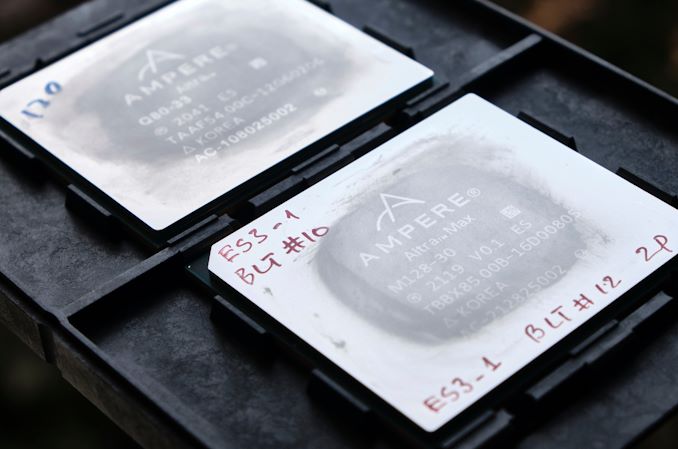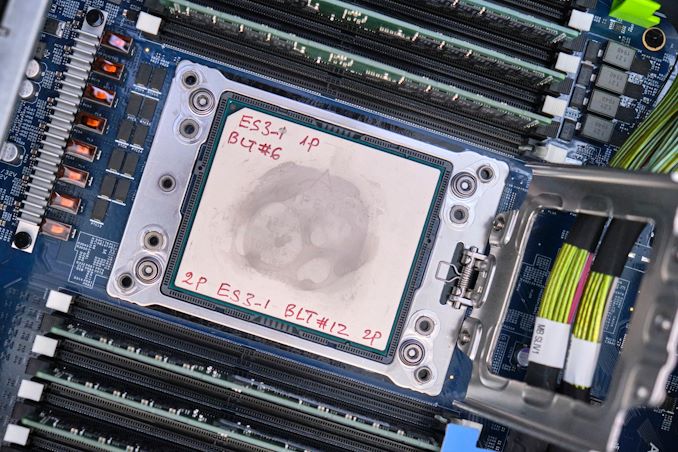The Ampere Altra Max Review: Pushing it to 128 Cores per Socket
by Andrei Frumusanu on October 7, 2021 8:00 AM EST- Posted in
- Servers
- Arm
- Neoverse N1
- Ampere
- Altra Max

It’s been a little over a year since Ampere started to deliver their first generation Altra processors. The “Quicksilver” design with 80 Neoverse N1 cores was the first merchant Arm silicon on the market who really went “all-out” in terms of performance targets, aiming for the best of what AMD and Intel had to offer, ending up in a very competitive standing against the newest EPYC CPUs and leapfrogging Intel’s offerings.
Since that first review, the competition has released two new generation platforms, the newer EPYC Milan chips, showcasing a good generational boost, and Intel dramatically narrowing the performance gap with the new Ice Lake-SP Xeon parts.
Related Reading:
-
The Ampere Altra Review: 2x 80 Cores Arm Server Performance Monster
-
AMD EPYC Milan Review Part 2: Testing 8 to 64 Cores in a Production Platform
-
AMD 3rd Gen EPYC Milan Review: A Peak vs Per Core Performance Balance
-
Intel 3rd Gen Xeon Scalable (Ice Lake SP) Review: Generationally Big, Competitively Small
For the Arm ecosystem and Ampere in particular, things naturally also aren’t standing still; following the first-gen 80-core Quicksilver design, we had long expected the 128-core “Mystique” Altra Max design. Arguably a bit late compared to Ampere’s initial Q4 2020 projections, we’ve now finally had our hands on the new many-core monster for today’s initial review.
Pushing it to 128 Cores
The new Altra Max is a quite exciting part, but it’s also relatively straightforward design compared to the original Altra parts. While the original chip had been pushing 80 Neoverse-N1 cores, the new Altra Max is pushing 128 cores. While there are also slightly improved technical differences between the two chip generations, that is mostly the main large differentiation between the two designs.
Ampere is still continuing to offer both Altra and Altra Max chips in their product line-up, with the Max parts in particular filling the high-core count SKU segment:
| Ampere Altra SKU List | ||||||
| AnandTech | Cores | Frequency | TDP | PCIe | DDR4 | Price |
| Altra Max "Mystique" | ||||||
| M128-30 (Tested) |
128 | 3.0 GHz | 250 W | 128x G4 | 8 x 3200 | $5800 |
| M128-28 | 128 | 2.8 GHz | 230 W | 128x G4 | 8 x 3200 | $5500 |
| M128-26 | 128 | 2.6 GHz | 190 W | 128x G4 | 8 x 3200 | $5400 |
| M112-30 | 112 | 3.0 GHz | 240 W | 128x G4 | 8 x 3200 | $5100 |
| M96-30 | 96 | 3.0 GHz | 220 W | 128x G4 | 8 x 3200 | $4550 |
| M96-28 | 96 | 2.8 GHz | 190 W | 128x G4 | 8 x 3200 | $4250 |
| Altra "Quicksilver" | ||||||
| Q80-33 (Tested) |
80 | 3.3 GHz | 250 W | 128x G4 | 8 x 3200 | $4050 |
| Q80-30 | 80 | 3.0 GHz | 210 W | 128x G4 | 8 x 3200 | $3950 |
| Q80-26 | 80 | 2.6 GHz | 175 W | 128x G4 | 8 x 3200 | $3810 |
| Q72-30 | 72 | 3.0 GHz | 195 W | 128x G4 | 8 x 3200 | $3590 |
| Q64-33 | 64 | 3.3 GHz | 220 W | 128x G4 | 8 x 3200 | $3810 |
| Q64-30 | 64 | 3.0 GHz | 180 W | 128x G4 | 8 x 3200 | $3480 |
| Q64-26 | 64 | 2.6 GHz | 125 W | 128x G4 | 8 x 3200 | $3260 |
| Q64-24 | 64 | 2.4 GHz | 95 W | 128x G4 | 8 x 3200 | $3090 |
| Q32-17 | 32 | 1.7 GHz | 45 W | 128x G4 | 8 x 3200 | $800 |
The unit we’re testing today, the flagship Altra Max M128-30, with 128 cores and a 3.0GHz clock (again, noteworthy congratulations of Ampere’s straightforward and descriptive part naming), with a maximum TDP of 250W.
Much like the first-generation parts, platform side features are all identical throughout the product stack, always featuring the maximum 128 lanes of PCIe 4.0 and 8-channel DDR4-3200 capabilities.
Comparing the M128-30 to the Q80-33, the new Altra Max part is able to fit in 60% more cores, albeit at 10% lower frequency, within the same advertised TDP. It’s to be noted that TDP here doesn’t mean power consumption, and in our initial review of the Q80-33 we noted that the chip in many workloads hovered at power levels much below the TDP, possibly explaining why and Ampere was able to grow the core count this much even though the chip isn’t on a fundamentally different process node (TSMC N7), though it’s on a better implementation.
The SKU list for the new Altra Max parts is interesting in that there’s only parts from 96 cores onwards, with anything below that still being serviced by the original Altra SKUs. It’s very likely that due to the process node maturity of the N7 node that Ampere here likely has few chips yielding with fewer cores, and the higher clocks and larger cache of the Quicksilver chips would be better served for lower core count deployments anyhow.
In terms of pricing, Ampere is quite aggressive, vastly undercutting both AMD and Intel’s flagship parts MSRPs, though as always, what large customers and hyperscalers pay are most of the time never in line with those prices anyhow – but it’s still a large win for Ampere in terms of visible pricing.
The Altra Max is extremely straightforward in terms of deployment: following some initial required firmware updates, it’s essentially a drop-in solution on the existing Altra platforms, which is exactly what we did for our review, re-using the original Mount Jade reference server from Wiwynn. The only practical note to make here is that at time of writing, Ampere currently doesn’t have a dual capable firmware stack that would enable swapping around from Altra to Altra Max and vice-versa, our initial setup was a one-way upgrade, with interoperability firmware still being something in the works for the future.












60 Comments
View All Comments
Unashamed_unoriginal_username_x86 - Thursday, October 7, 2021 - link
M112-30 in the table on first page says 96 cores?Andrei Frumusanu - Friday, October 8, 2021 - link
That was a typo.Unashamed_unoriginal_username_x86 - Friday, October 8, 2021 - link
I'm glad we agreenandnandnand - Thursday, October 7, 2021 - link
Let's all run out and buy the $800 32-core.mode_13h - Friday, October 8, 2021 - link
Add in platform costs and it's not going to look like much of a bargain compared with a Threadripper or Xeon W-3300 system.mode_13h - Friday, October 8, 2021 - link
Of course, if you happen to need specifically an ARM-based workstation, I'm not aware of any better option than Altra.Brutalizer - Sunday, October 10, 2021 - link
The old SPARC T8 cpu with 32 cores, is still almost faster than all these cpus. Here in the SPECjbb2015, a single cpu achieves 153.500 max, and 90.000 crit.https://blogs.oracle.com/bestperf/specjbb2015:-spa...
Wilco1 - Sunday, October 10, 2021 - link
Those are results based on weeks/months of tuning, so not at all comparable with this review (the same is true for SPEC scores). In your link a 1S 8180 does 84100 max-jOPS, while the faster 8280 gets 81700 in this review. Similarly the best critical-jOPS is 62600 for the 8180 while the 8280 gets just 47900.Sudharshan Anbarasu - Sunday, October 17, 2021 - link
How about Monero Mining performance...Since $(cache) plays major role in x86 platform, curious to know how it works in Arm architecture.